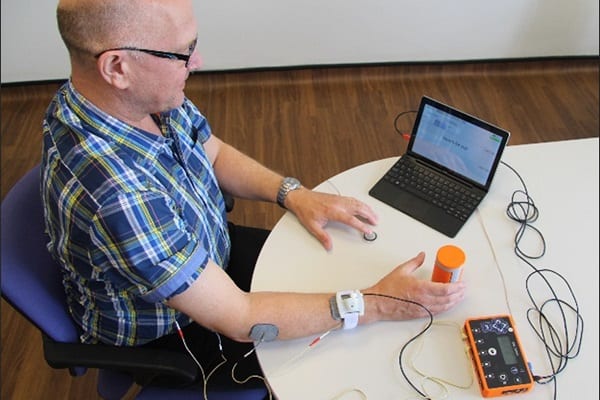Every day, researchers around the world are working to improve the lives of those with limb differences. In today’s snapshot, we take a quick look at the work being done by the Human Movement and Rehabilitation group at the University of Salford in the U.K.
In Their Own Words…

The Human Movement and Rehabilitation research group comprises engineers, psychologists, and clinicians working on a number of different research problems, ranging from foot health, through health interventions for people with arthritis, to prosthetics. One of the key areas for our group is to better understand the problems with current prostheses and use this information to guide the design of new prostheses. We also host the UK Centre for Doctoral Training in Prosthetics and Orthotics, a global first for the sector. Our prosthetics work spans both upper and lower limb applications, as outlined below.
Lower Limb Prosthetics
In an intact ankle, tendons crossing the joint store energy during the stance phase of walking prior to push-off and release it during push-off, providing forward propulsion. Most prosthetic feet currently on the market – both conventional and energy storage and return (ESR) feet – fail to replicate this energy-recycling behaviour. Specifically, they cannot plantarflex beyond their neutral ankle angle (i.e. a 90° angle between the foot and shank) while generating the plantarflexion moment required for normal push-off. This results in a metabolic cost of walking for lower-limb amputees higher than for anatomically intact subjects, combined with a reduced walking speed. Common approaches to this problem include the use of unpowered clutch-and-spring devices, but these cannot provide biomimetic control of prosthetic ankle torque. Adding a battery and electric motor(s) may provide both the necessary push-off power and biomimetic ankle torque, but add to the size, weight and cost of the prosthesis.
Led by Professor Howard, we have designed prosthetic ankles based on miniature hydraulics showing that such an approach can deliver biomimetic control of ankle torque and push-off power [1]. The most recent work by Dr Anna Pace has shown how such an approach can be implemented based on simple and easily manufactured hydraulic components, opening up opportunities to translate the work into practice[2].
As well as the work on design, we have also carried out research to better understand amputee gait, including novel outcome measures based on energy flow [3], and more clinically focused work to evaluate prosthetic componentry in collaboration with colleagues in University of Hull and others [4].
Upper Limb Prosthetics
Our work on restoring upper limb function addresses both prostheses for people with limb absence and neural prostheses for people who have had a stroke.
Neural Prostheses
Following a stroke, between 40% and 70% of patients are left with reduced upper limb function. Large trials of conventional therapy approaches have shown generally disappointing results, in part due to the low intensities of rehabilitation offered to participants. Recent work has shown promising results from a programme of therapy involving the practice of meaningful tasks for 30 hours per week, a level that is simply not feasible to deliver in routine clinical practice using traditional hands-on approaches. We developed a system which uses electrical stimulation of arm muscles to support patients in practicing relevant tasks such as picking up and drinking from a cup, while simultaneously offering automated feedback on their performance [5]. Crucially, and in contrast to some other similarly sophisticated systems, we showed that it could be set up and used in a range of different care settings by therapy assistant staff [6]. The work led to a spin-out company, Bet R Medical (China) who have sponsored a PhD student, Jasmine Sarwar, to further develop the approach.
Follow Us
Prosthetic Limbs
We have carried out a series of studies to better understand the problems faced by users of myoelectric prostheses. These have shown that unreliability of current systems, associated with the movement of the socket (and hence electrodes) relative to the underlying skin, may be a key issue that has yet to be properly solved[7, 8]. As part of this research we have pioneered the use of body/prosthesis worn monitors to collect objective data on real world use of prostheses. The results have shown that users of myoelectric prostheses are heavily reliant on their sound limb during everyday life. Building on this work, we are now collaborating with prosthetics company Covvi, and collaborators at the University of Newcastle and University of Edinburgh on a project to develop more reliable upper limb prostheses.
We recognise that battery-powered, myoelectric devices may not be suitable for the majority of the world’s upper limb amputees, who are poor and have limited access to reliable charging points or repair facilities. In the Fit for Purpose upper limb prosthetics project we are working with partners in Uganda, Jordan and elsewhere in the UK to develop purely mechanical designs which may offer more suitable solutions. Early work has led to insights into the challenges faced by the Ugandan [9] and Jordanian prosthetics services, which in turn have informed work on the design of adjustable sockets [10]. As we are aware that the acid test for any upper limb prosthesis is the extent to which it is used by the recipient in their daily lives, we are further developing methods with which to evaluate real world use [11]. This work has been carried out in collaboration with another project involving Salford and led by the University of Southampton. The focus for this work is on digital tools to support prosthetic services in lower and middle income countries and is in partnership with a team in Cambodia.
Acknowledgements
We would like to acknowledge the support of the participants in our studies, without whom the work would not be possible. We would also like to acknowledge our funders, including the Engineering and Physical Sciences Research Council, National Institute for Health Research, and the Global Challenges Research Fund.
References
[1] Gardiner, J., et al., Performance of Optimized Prosthetic Ankle Designs That Are Based on a Hydraulic Variable Displacement Actuator (VDA). Ieee Transactions on Neural Systems and Rehabilitation Engineering, 2017. 25(12): p. 2418-2426.
[2] Pace, A., A novel hydraulic energy-storage-and-return prosthetic ankle: Design, modelling and simulation. 2020, University of Salford.
[3] Weinert-Aplin, R.A., et al., Energy flow analysis of amputee walking shows a proximally-directed transfer of energy in intact limbs, compared to a distally-directed transfer in prosthetic limbs at push-off. Med Eng Phys, 2017. 39: p. 73-82.
[4] Mitchell, N., et al., Self-aligning prosthetic device for older patients with vascular-related amputations: protocol for a randomised feasibility study (the STEPFORWARD study). BMJ Open, 2019. 9(9): p. e032924.
[5] Sun, M., et al., FES-UPP: A Flexible Functional Electrical Stimulation System to Support Upper Limb Functional Activity Practice. Front Neurosci, 2018. 12: p. 449.
[6] Smith, C., et al., A Three-Site Clinical Feasibility Study of a Flexible Functional Electrical Stimulation System to Support Functional Task Practice for Upper Limb Recovery in People With Stroke. Front Neurol, 2019. 10: p. 227.
[7] Chadwell, A., et al., Upper limb activity in myoelectric prosthesis users is biased towards the intact limb and appears unrelated to goal-directed task performance. Sci Rep, 2018. 8(1): p. 11084.
[8] Chadwell, A., et al., The Reality of Myoelectric Prostheses: Understanding What Makes These Devices Difficult for Some Users to Control. Front Neurorobot, 2016. 10: p. 7.
[9] Kenney, L., et al., Prosthetics services in Uganda: A series of studies to inform the design of a low cost, but fit for purpose, body powered prosthesis., in Global perspectives on assistive technology: proceedings of the GReAT Consultation 2019. 2019: World Health Organisation, Geneva. p. 414-426.
[10] Prince, M., L.P. Kenney, and D. Howard, A pin-array method for capturing tissue deformation under defined pressure distributions and its application to prosthetic socket design. Med Eng Phys, 2020. 84: p. 136-143.
[11] Chadwell, A., et al., Technology for monitoring everyday prosthesis use: a systematic review. J Neuroeng Rehabil, 2020. 17(1): p. 93.
About This Research Snapshot Series of Articles
As most of you know, our main mission at BionicsForEveryone.com is to help those with physical or neurological disabilities understand their technology options free of commercial influence. Put another way, we side 100 % with the little guy.
It can be difficult dealing with a loss of mobility, especially if it’s sudden. One’s optimism can be challenged.
That’s why we are thrilled to bring you these snapshots of what some extremely talented and dedicated people are doing to help. Their methods may be pure science but their mission inspires hope.
Related Information
For more information on upper-limb bionics, please see our Complete Guide to Bionic Arms & Hands.
For more information on lower-limb bionics, please see our Complete Guide to Bionic Legs & Feet.
